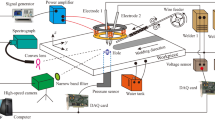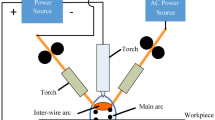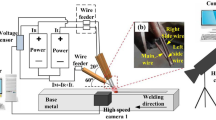Abstract
In this paper, a self-designed cusp external magnetic field (EMF) was employed to assist the two-electrode TIG (T-TIG), and its common conductive channel characteristics were aimed to optimize the energy distribution of T-TIG. The influences of the cusp EMF on arc morphology, arc plasma information, and arc pressure of T-TIG were respectively analyzed based on a high-speed camera, spectrograph, and pressure sensor. The results showed that the cusp EMF could compress T-TIG in the direction parallel to the array of two electrodes of T-TIG, and thus, a common conductive channel with stronger brightness and higher stiffness was obtained. Besides, by applied cusp EMF, the electron temperature and electron density of the common conductive channel of T-TIG were increased, and in the radial, the distributions of electron temperature and electron density of T-TIG were more concentrated. Under the condition of welding current of 40 A + 40 A, the electron density on the central axis of T-TIG could be increased by 16% by applied cusp EMF with a 30 A excitation current. In addition, the enhanced common conductive channel characteristics of T-TIG by the cusp EMF caused the arc pressure on the central axis of T-TIG to be increased by 14%, which was beneficial to improve the weld penetration.



















Similar content being viewed by others
Data availability
All the data have been presented in the manuscript.
References
Kobayashi K, Yamada M, Fujishima K, Iijima T, Ushio M (2004) Development of high efficiency twin-arc TIG welding method. IIW Doc XII:1669-1701
Leng X, Zhang G, Wu L (2006) Experimental study on improving welding efficiency of twin electrode TIG welding method. Sci Technol Weld Join 11:550–554
Leng X, Zhang G, Wu L (2006) The characteristic of twin-electrode TIG coupling arc pressure. J Phys D Appl Phys 39:1120–1126
Wu D, Huang J, Kong L, Hua X, Wang M (2020) Coupled mechanisms of arc, weld pool and weld microstructures in high speed tandem TIG welding. Int J Heat Mass Transf 154:119641
Ogino Y, Hirata Y, Nomura K (2011) Numerical analysis of the heat source characteristics of a two-electrode TIG arc. J Phys D Appl Phys 44:215202
Ogino Y, Hirata Y, Kawata J, Nomura K (2013) Numerical analysis of arc plasma and weld pool formation by a tandem TIG arc. Weld World 57:411–423
Wang X, Luo Y, Wu G, Chi L, Fan D (2018) Numerical simulation of metal vapour behavior in double electrodes TIG welding. Plasma Chem Plasma Process 38:1095–1114
Wang X, Fan D, Huang J, Huang Y (2014) A unified model of coupled arc plasma and weld pool for double electrodes TIG welding. J Phys D Appl Phys 47:275202
Tsai NS, Eagar TW (1985) Distribution of the heat and current fluxes in gas tungsten arcs. Metall Trans B 16:841–846
Wu H, Chang Y, Lu L, Bai J (2017) Review on magnetically controlled arc welding process. Int J Adv Manuf Technol 91:4263–4273
Wang J, Sun Q, Feng J, Wang S, Zhao H (2017) Characteristics of welding and arc pressure in TIG narrow gap welding using novel magnetic arc oscillation. Int J Adv Manuf Technol 90:413–420
Sun Q, Wang J, Cai C, Li Q, Feng J (2016) Optimization of magnetic arc oscillation system by using double magnetic pole to TIG narrow gap welding. Int J Adv Manuf Technol 86:761–767
Yin X, Gou J, Zhang J, Sun J (2012) Numerical study of arc plasmas and weld pools for GTAW with applied axial magnetic fields. J Phys D Appl Phys 45:285203
Xiao L, Fan D, Huang J (2018) Tungsten cathode-arc plasma-weld pool interaction in the magnetically rotated or deflected gas tungsten arc welding configuration. J Manuf Process 32:127–137
Liu S, Liu Z, Zhao X, Fan X (2020) Influence of cusp magnetic field configuration on K-TIG welding arc penetration behavior. J Manuf Process 53:229–237
Liu Z, Chen S, Yuan X, Zuo A, Zhang T, Luo Z (2018) Magnetic-enhanced keyhole TIG welding process. Int J Adv Manuf Technol 99:275–285
Wang L, Chen J, Wu C, Luan S (2020) Numerical analysis of arc and droplet behaviors in gas metal arc welding with external compound magnetic field. J Mater Process Technol 282:116638
Chen J, Zhang Y, Wu C, Padhy GK (2019) Suppression of undercut defects in high-speed GMAW through a compound magnetic field. J Mater Process Technol 274:116288
Liu L, Chen M, Li C (2013) Effect of electric arc on laser keyhole behavior based on direct observation during low power pulsed laser–arc hybrid welding process. Opt Lasers Eng 51:1153–1160
Chen M, Xin L, Zhou Q, He L, Wu F (2018) Effect of laser pulse on alternative current arc discharge during laser-arc hybrid welding of magnesium alloy. Opt Lasers Eng 100:208–215
Kumar A, DebRoy T (2003) Calculation of three-dimensional electromagnetic force field during arc welding. J Appl Phys 94:1267–1277
Qi B, Yang M, Cong B, Liu F (2013) The effect of arc behavior on weld geometry by high-frequency pulse GTAW process with 0Cr18Ni9Ti stainless steel. Int J Adv Manuf Technol 66:1545–1553
Lin ML, Eagar TW (1986) Pressures produced by gas tungsten arcs. Metall Trans B 17:601–607
Lago F, Gonzalez JJ, Freton P, Gleizes A (2004) A numerical modelling of an electric arc and its interaction with the anode: Part I. The two-dimensional model. J Phys D Appl Phys 37:883–897
Ueyama T, Ohnawa T, Tanaka M, Nakata K (2007) Occurrence of arc interaction in tandem pulsed gas metal arc welding. Sci Technol Weld Join 12:523–529
Maecker H (1955) Plasmastromungen in lichtbogen infolge eigenmagnetischer compression. Z Phys 141:198–216
Ando K, Hasegawa M (1985) The phenomenon of welding arc. China Machine Press, Beijing in Chinese
Funding
This work was supported by the National Key Research and Development Program of China(2018YFB1107900), and the National Natural Science Foundation of China (No. U1960111).
Author information
Authors and Affiliations
Contributions
Yanli Zhu: methodology, writing-original draft, formal analysis.
Xinkun Xu: supervision, validation.
Runtao Liu: conceptualization.
Liming Liu: conceptualization, writing-review and editing, funding acquisition.
Corresponding author
Ethics declarations
Ethics approval
The paper follows the guidelines of the Committee on Publication Ethics(COPE).
Consent to participate
The authors declare that they all consent to participate this research.
Consent for publication
The authors declare that they all consent to publish the manuscript.
Competing interests
The authors declare no competing interests.
Additional information
Publisher’s note
Springer Nature remains neutral with regard to jurisdictional claims in published maps and institutional affiliations.
Rights and permissions
About this article
Cite this article
Zhu, Y., Xu, X., Liu, R. et al. Magnetic-enhanced common conductive channel characteristics of two-electrode TIG. Int J Adv Manuf Technol 116, 3217–3229 (2021). https://doi.org/10.1007/s00170-021-07674-3
Received:
Accepted:
Published:
Issue Date:
DOI: https://doi.org/10.1007/s00170-021-07674-3




